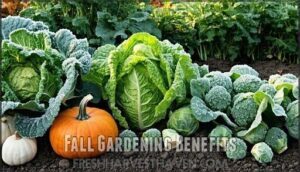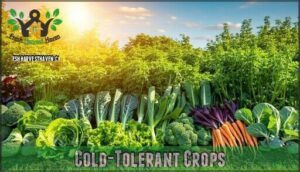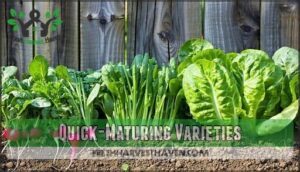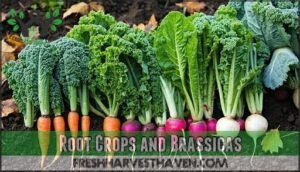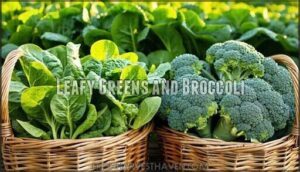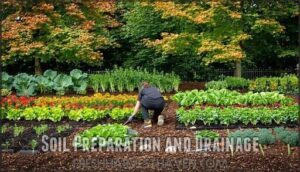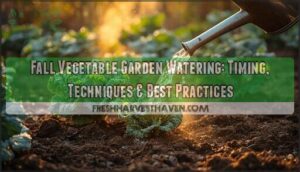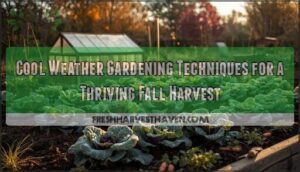This site is supported by our readers. We may earn a commission, at no cost to you, if you purchase through links.
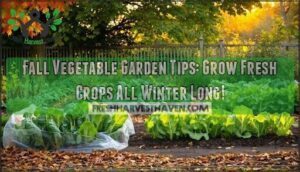 Your fall vegetable garden tips start with timing—plant 12-14 weeks before your first frost date for best results.
Your fall vegetable garden tips start with timing—plant 12-14 weeks before your first frost date for best results.
Choose cold-hardy champions like kale, carrots, and Brussels sprouts that actually taste sweeter after light frost hits.
Prepare your soil with compost and make certain proper drainage since fall rains can waterlog beds.
Start seeds indoors during summer’s heat, then transplant when temperatures cool.
Use row covers to extend your season and protect tender crops from unexpected cold snaps.
Water consistently but avoid overwatering in cooler weather.
The real game-changer isn’t just what you plant, but understanding how autumn’s unique growing conditions can triple your harvest potential.
Table Of Contents
- Key Takeaways
- Fall Gardening Benefits
- When to Plant Fall Garden
- Choosing Fall Vegetables
- Planting and Care Tips
- Fall Garden Maintenance
- Frequently Asked Questions (FAQs)
- What do I do with my vegetable garden in the fall?
- When should I start my fall vegetable garden?
- What is the best vegetable to grow in the fall?
- How do I prepare my soil for a fall vegetable garden?
- Is September too late to plant fall vegetables?
- How much water do fall vegetables need?
- What fertilizers work best for fall crops?
- Can I start a fall garden indoors?
- Which tools are essential for fall gardening?
- How do I prepare garden beds after summer?
- Conclusion
Key Takeaways
- Time your planting correctly – You’ll need to count backward from your first frost date and add 2 weeks to account for slower fall growth, ensuring your crops mature before winter hits.
- Choose cold-hardy vegetables – Focus on frost-tolerant crops like kale, carrots, and Brussels sprouts that actually taste sweeter after light frost exposure and can withstand cooler temperatures.
- Prepare your soil properly – Add compost to improve drainage and nutrients, then use mulch and row covers to protect plants from temperature fluctuations and extend your growing season.
- Take advantage of fall’s natural benefits – You’ll deal with fewer pests, reduced watering needs, and less stressful growing conditions compared to summer gardening, making maintenance much easier.
Fall Gardening Benefits
You’ll discover that fall gardening offers surprising advantages over spring planting, from fewer pests and weeds to naturally cooler temperatures that reduce watering needs.
Your autumn crops will actually taste sweeter after frost exposure, while the still-warm soil helps seeds germinate faster than they’d in chilly spring conditions, which is a significant advantage due to the naturally cooler temperatures.
Mother Nature’s sweet surprise: frost transforms ordinary vegetables into candy-crisp treasures worth waiting for.
Reduced Stress on Crops
Fall gardening transforms your growing experience into something beautifully manageable.
Your fall vegetable garden thrives with less stress as nature works in your favor, creating ideal conditions that summer simply can’t match.
Here’s how Fall Crop Health improves naturally:
- Pest Reduction – Insects disappear as temperatures drop, eliminating spray schedules
- Weed Control – Fewer weeds emerge in cooler soil conditions
- Watering Needs – Rainier weather means less watering and lower bills
- Temperature Impact – Crops grow steadily without heat stress damage
Cooler Weather Advantages
As autumn arrives, your fall vegetable garden transforms into a gardener’s paradise.
Cool season crops thrive in these moderate temperatures, making fall gardening far more pleasant than battling summer’s scorching heat.
You’ll discover faster germination in warm soil while enjoying reduced pests that naturally decline with cooler weather.
Less watering becomes necessary as gentle rains help with irrigation.
The best part? Frost sweetness develops in many vegetables after light freezes, creating flavors impossible during hot months.
Cool weather turns fall garden planning into enjoyable gardening.
Gardeners can also leverage the extended growing season by planting quick-maturing varieties.
Extended Harvest Season
Your fall vegetable garden doesn’t need to end with the first frost.
Succession planting extends your growing season well into winter, giving you fresh harvests when others rely on expensive store-bought produce.
- Staggered planting delivers continuous harvest through December
- Late-season crops thrive in cool weather conditions
- Overwintering veggies survive harsh winters with basic frost protection
- Cool season crops actually taste sweeter after cold exposure
Improved Soil Conditions
Your garden’s soil becomes a powerhouse during autumn months.
Warm earth temperatures boost seed germination while cooler air reduces stress.
Compost amendments and organic matter decompose faster, improving drainage solutions naturally.
Adding kelp benefits provides essential nutrients for soil health.
Strategic mulch types like shredded leaves insulate roots and retain moisture.
This perfect soil preparation window allows effective compost addition and soil feeding through natural processes, creating ideal conditions for soil testing and long-term garden success.
When to Plant Fall Garden
Timing your fall garden correctly means working backward from your area’s first frost date and subtracting each crop’s days to maturity.
You’ll want to add an extra two weeks to account for shorter days and cooler temperatures that slow growth, ensuring your vegetables reach harvest before winter arrives, considering the days to maturity.
Determining Frost Dates
Knowing your first frost date is like having a crystal ball for your fall planting guide.
Use online frost date calculators with your zip code to access historical data usage and predictive modeling.
These vegetable garden tips reveal when Jack Frost visits your neighborhood.
Remember, microclimate considerations and zone specificity matter—your backyard’s frost date impact might differ from your neighbor’s growing vegetables fall timeline, considering the importance of fall planting.
Using Planting Calendars
Once you’ve pinpointed your frost dates, planting calendars become your secret weapon for fall garden planning success.
These specialized fall planting guides take the guesswork out of timing by providing precise schedules customized to your location.
Your planting calendar should account for several key factors:
- Calendar Accuracy – Use local frost date calculators rather than generic charts for your exact zip code
- Zone Differences – USDA Zones vary substantially, so verify your specific hardiness zone requirements
- Microclimates Impact – Your yard’s unique conditions may create warmer or cooler pockets than surrounding areas
- Succession Planting – Schedule new sowings every 7-10 days to extend your harvest window
- Specific Variety Timing – Different cultivars within the same vegetable family have varying maturity rates
Think of your planting calendar as your garden’s GPS – it’ll navigate you toward a bountiful autumn harvest without any wrong turns.
To maximize your yield, consider using a calendar that provides ideal planting times for your specific crops.
Scheduling Harvest Time
Successfully planning your fall garden harvest timing starts with working backward from your first frost date.
Calculate each crop’s maturity period, then add two weeks to account for slower autumn growth. This approach guarantees you’ll gather fresh produce before hard freezes damage your plants.
Root vegetables like carrots need 70-80 days but develop peak sweetness after light frost impact. Leafy greens mature quickly (30-50 days) and support succession planting for continuous harvests.
Brassicas require longer growing periods but reward patience with enhanced cold-weather flavor.
Understanding vegetable maturity helps you master storage preparation for winter abundance.
Accounting for Cooler Temperatures
Cool fall temperatures naturally slow plant growth, making maturity adjustment essential for successful harvests.
When autumn’s chill slows your garden’s pace, smart timing becomes your harvest’s best friend.
Your frost protection vegetables need extra time to develop properly before winter arrives.
Here’s your cold hardiness game plan:
- Add two weeks to seed packet maturity dates for accurate frost protection planning
- Monitor soil temperature and identify warm microclimates in your yard for microclimate management
- Choose coldtolerant vegetables based on your specific frost dates and overwintering strategies
- Plan fall garden preparation early to maximize your extending growing season potential
This adjustment guarantees thriving autumn harvests.
Choosing Fall Vegetables
You’ll want to focus on cold-tolerant, quick-maturing vegetables that thrive in cooler temperatures and shorter daylight hours.
Smart choices include leafy greens like spinach and lettuce that mature in 30-50 days, plus hardy root crops like radishes and carrots that actually taste sweeter after frost hits.
Cold-Tolerant Crops
Your fall garden’s success hinges on choosing vegetables that laugh in the face of Jack Frost. These Frost-Hardy Varieties are nature’s tough guys, transforming chilly nights into opportunities for sweeter, more flavorful harvests.
Cold temperatures actually trigger a survival mechanism in many vegetables, causing them to produce sugars that act as natural antifreeze. This Cold Sweetness makes frost-kissed carrots taste like candy and transforms bitter greens into tender delicacies.
Here are five champion coldtolerant vegetables that’ll keep your Fall Crop Protection game strong: For a successful fall harvest, consider implementing strategies for pest control naturally.
- Kale survives bone-chilling 10°F temperatures while delivering nutrient-packed leaves
- Brussels sprouts develop their signature sweet flavor after light frost kisses
- Carrots withstand hard freezes with simple mulch protection, growing sweeter underground
- Spinach overwinters like a champ in most climates, providing fresh Overwintering Greens
- Collard greens handle brutal 5°F temperatures, making them ultimate frosttolerant crops for Extending Harvests
Quick-Maturing Varieties
Time’s ticking toward frost, but Fast Fall Crops won’t leave you empty-handed.
Rapid Radishes sprint to your table in just 25 days, while Speedy Salad Greens like arugula finish their race in 30-40 days.
These quick-maturing crops are your ace in the hole for fall gardening success.
Plant Quick Turnips every two weeks for continuous harvests through your fall garden planting season.
Root Crops and Brassicas
Beyond just surviving cold weather, root crops and brassicas become your fall vegetable garden’s dynamic duo.
These cool weather champions actually improve with frost – carrot varieties develop deeper sweetness while turnips store better after chilly nights.
Your radish spacing of 1-2 inches apart delivers harvests in just 25 days, perfect for quick gardening wins.
Here’s why these crops excel together:
- Complementary growth patterns – Root crops like carrots loosen soil while brassicas like kale grow above ground, maximizing space without competition.
- Extended harvest windows – Quick radishes satisfy immediate needs while slower turnip storage and kale frost tolerance keep producing through winter.
- Natural pest management – Rotating between root crops and brassicas breaks pest cycles, keeping your fall gardening healthier without chemicals.
The beet sweetness alone makes this combination worth trying.
Leafy Greens and Broccoli
When autumn arrives, leafy greens and broccoli varieties become your vegetable garden’s MVPs.
Start broccoli seedlings in late summer since they need 12-14 weeks before frost hits. Leafy greens like spinach and kale handle cold like champs—kale survives down to 20°F!
Use succession planting tips every two weeks for continuous harvests. Plant seeds slightly deeper than spring to reach moist soil.
Smart fall planting with proper pest control and harvesting tips keeps your fall gardening productive through winter. For ideal growth, remember to test your soil pH before planting.
Planting and Care Tips
Once you’ve selected your fall vegetables, proper planting and care techniques will make the difference between a struggling garden and a bountiful harvest.
You’ll need to focus on soil preparation, consistent watering, and protective measures to help your crops thrive in autumn’s changing conditions, ensuring a successful and thriving garden.
Soil Preparation and Drainage
Successfully preparing your fall garden begins with understanding your soil needs.
Start by testing soil pH—most vegetables thrive between 6.0-7.0.
Poor garden soil can sabotage even the best plans, so don’t skip this vital step.
Next, enhance soil health through strategic improvements.
Work compost amendments into the top six inches to boost nutrients and improve structure.
In clay-heavy areas, focus on drainage improvement by creating raised beds or adding coarse sand.
To guarantee proper nutrient uptake, remember to assess and adjust soil pH levels.
Finally, protect your investment with proper finishing touches:
- Apply two-inch mulch types around plants to retain soil warmth
- Implement effective tilling practices to avoid compacting wet soil
- Monitor moisture levels regularly to maintain ideal growing conditions
These steps create the foundation your fall garden needs to flourish.
Seed Germination and Thinning
Proper seed germination starts with understanding germination temperature and soil warmth.
Plant seeds at the recommended seed depth—slightly deeper in fall’s warm soil for better moisture retention.
Pelletized seeds help achieve precise spacing requirements.
Once seedlings show seedling vigor, thin according to spacing needs using scissors rather than pulling.
These thinning methods prevent root damage while ensuring ideal planting depth for healthy growth.
Row Covers and Mulching
Once your seedlings establish themselves, you’ll want to give them the VIP treatment with proper row covers and mulching. Think of these as your fall garden’s insurance policy against unpredictable weather.
Row cover materials and mulch types work together like a tag team, delivering frost protection while boosting water retention. Your fall garden will stay cozy even when temperatures drop unexpectedly.
Here’s your protection playbook:
- Lightweight fabric row covers – Choose spun fabric that allows 85% light through while blocking cold winds
- Organic mulch options – Apply 2-3 inches of straw, shredded leaves, or grass clippings around plants
- Plastic mulch sheets – Use black plastic to warm soil faster and prevent weeds
- Floating row covers – Install hoops to create an insulated microclimate for tender crops
- Layered mulching system – Combine organic mulch with row covers for maximum fall garden protection
This fall garden mulching and fall garden row cover strategy extends your harvest window substantially while reducing maintenance headaches. You can find various garden row covers for different needs.
Pest and Disease Management
While row covers protect your plants, you’ll need additional fall pest control strategies to keep your garden healthy.
Disease prevention starts with removing infected plants immediately – don’t let problems spread. Crop rotation breaks pest cycles, while proper spacing improves airflow around plants.
Organic solutions like neem oil tackle persistent fall garden pests and fall garden diseases without harsh chemicals. You can find products for pest control to help manage infestations.
Watch for cabbage moth larvae on brassicas. Encourage beneficial insects by avoiding excessive pesticides – they’re your best allies for natural pest control and disease management.
Fall Garden Maintenance
Your fall garden won’t maintain itself, so you’ll need to stay on top of harvesting, protecting plants from frost, and planning for next year’s growing season.
Smart maintenance practices like proper storage techniques and crop rotation will help you maximize your autumn harvest while setting up your garden for future success.
Harvesting and Storage Techniques
The moment you’ve been waiting for has arrived – your fall garden is ready to deliver its treasures.
Harvesting fall vegetables at the right time transforms good crops into exceptional ones.
Root vegetables like carrots and beets actually sweeten after the first frost hits, so don’t rush to pull them early.
Knowing when to harvest based on maturity indicators guarantees the best quality.
Optimal Timing matters most for peak flavor and nutrition.
Storage Methods keep your bounty fresh for months when done right.
Quick-blanch vegetables before freezing to lock in color and nutrients.
Root Cellars maintain ideal conditions at 32-40°F with high humidity.
You can even leave hardy crops in the ground, using straw as natural insulation.
These Preserving Techniques guarantee your fall garden harvest feeds you well into winter:
- Fresh-picked vegetables taste like sunshine captured in every bite
- Properly stored root crops provide comfort during cold winter nights
- Homegrown harvest techniques create memories that last generations
- Extending Freshness means fewer grocery store trips and more savings
- Your fall harvest becomes a source of pride shared with family
Overwintering and Protection Methods
Your fall garden doesn’t have to surrender when temperatures drop. Mulch Application creates a protective blanket—pile 4+ inches around root vegetables before hard freezes hit. Row Covers work like plant sweaters, shielding crops from frost while allowing light through. Cold Frames act as mini-greenhouses, extending harvests weeks beyond normal frost dates.
Winter Watering becomes minimal since covered soil retains moisture longer. Greenhouse Gardening offers ultimate frost protection for tender plants.
Row covers
Cold frames
These methods transform winter gardens into productive havens.
Crop Rotation and Planning
Smart crop rotation keeps your garden healthy and productive year after year.
Map this season’s plant families, then move brassicas, nightshades, and legumes to different beds for spring plantings.
This rotation strategy improves soil health while disrupting pest management cycles.
Plan your succession planting schedule and note companion planting winners—your future garden planning will thank you!
Seasonal Gardening Strategies
Building on your rotation plan, succession planting every two weeks keeps your harvest flowing like a well-oiled machine.
Zone-specific strategies and microclimate management help you maximize each garden section’s potential.
Companion planting boosts yields while vertical gardening saves space for more crops.
Track what works in your fall garden checklist—these seasonal gardening patterns become your blueprint for fall garden maintenance success year after year.
Frequently Asked Questions (FAQs)
What do I do with my vegetable garden in the fall?
Clear spent summer crops and plant cool-season vegetables like spinach, kale, and radishes.
You’ll enjoy less watering, fewer pests, and sweeter harvests.
Don’t forget to add compost and mulch for healthier soil.
When should I start my fall vegetable garden?
Good things come to those who don’t wait—you’ll want to plant mid-to-late summer, typically 8-12 weeks before your first frost date.
Check your local frost calculator and start planting immediately.
What is the best vegetable to grow in the fall?
Spinach takes the crown as fall’s superstar vegetable. You’ll get quick harvests in just 30 days, it sweetens after frost, and survives winter in most zones without protection.
How do I prepare my soil for a fall vegetable garden?
Ironically, while summer gardens demand constant attention, fall prep’s simpler.
You’ll clear spent crops, add compost to enrich soil, and incorporate kelp meal.
Water thoroughly, then mulch to retain moisture for your cool-season vegetables.
Is September too late to plant fall vegetables?
September isn’t too late for fall vegetables.
You can still plant quick-maturing crops like radishes, spinach, arugula, and lettuce.
Focus on varieties that mature in 25-50 days before your first frost arrives.
How much water do fall vegetables need?
Fall vegetables need 50% less water than summer crops due to cooler temperatures and higher humidity.
You’ll typically water once or twice weekly, providing about one inch total.
Check soil moisture regularly—it should feel damp, not soggy.
What fertilizers work best for fall crops?
Your fall crops thrive with balanced fertilizers containing equal nitrogen, phosphorus, and potassium.
Apply compost or granular 10-10-10 fertilizer before planting.
Side-dress leafy greens with nitrogen-rich fertilizer every three weeks for continuous growth.
Can I start a fall garden indoors?
Seeds are tiny promises waiting to sprout.
You can absolutely start your fall garden indoors.
Use seed trays for lettuce, spinach, and kale.
Transplant seedlings outdoors when they’re sturdy enough to handle cooler temperatures.
Which tools are essential for fall gardening?
You’ll need basic hand tools: a sturdy spade for digging, pruning shears for harvesting, a rake for soil prep, and a watering can.
Don’t forget a wheelbarrow for hauling compost and crops around.
How do I prepare garden beds after summer?
Despite what you might think, preparing beds doesn’t require hours of backbreaking work.
Simply clear spent summer crops, add a two-inch layer of compost, gently work it into soil, and water thoroughly before planting.
Conclusion
Success in autumn gardening isn’t rocket science—it’s simply about working with nature’s rhythm instead of against it.
These fall vegetable garden tips transform your space into a productive powerhouse when summer crops fade.
You’ll discover that cooler temperatures actually benefit many vegetables, creating sweeter flavors and reducing pest pressure.
Start planning your fall garden now, and you’ll enjoy fresh harvests well into winter while building healthier soil for next year’s growing season.
- https://joegardener.com/podcast/what-to-plant-now-fall-vegetable-garden
- https://www.gardendesign.com/vegetables/fall.html
- https://awaytogarden.com/what-to-plant-now-for-a-fall-vegetable-garden
- https://www.finegardening.com/project-guides/fruits-and-vegetables/preparing-your-garden-for-fall
- https://www.almanac.com/fall-vegetable-garden-cleanup-11-things-do-now

